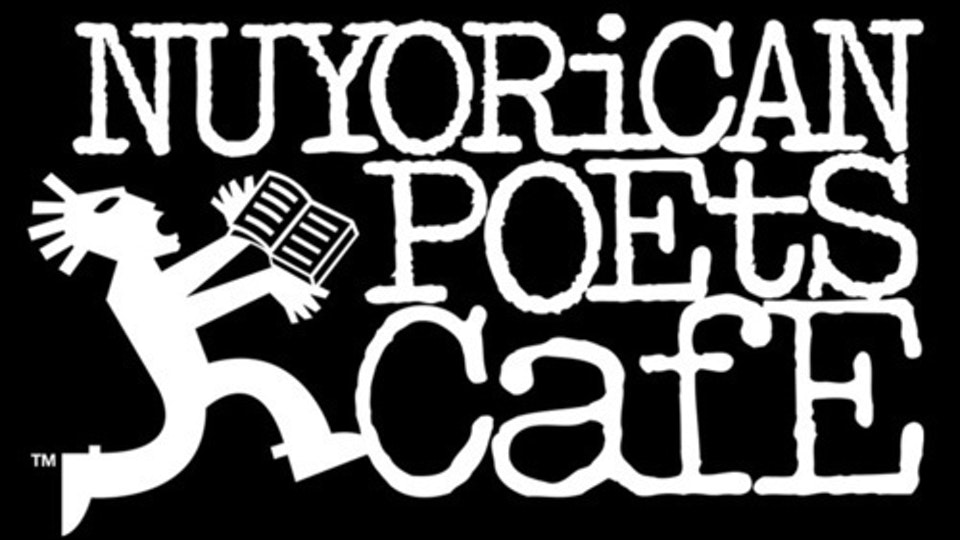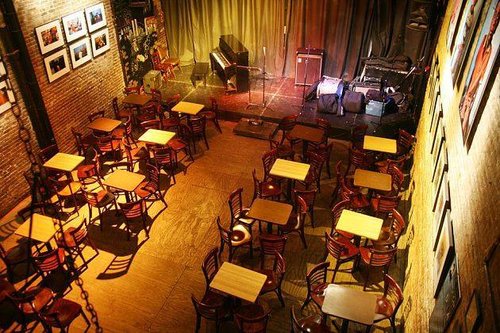Lois Elaine Griffith is here to tell you a story. An educator, poet, performer, and visual artist, Lois merged her multi-genre gift for storytelling into a career as a founding poet of the Nuyorican Poets Cafe who has advanced the Nuyorican’s message for more than 35 years. Now spearheading the Nuyorican Poets Cafe Founders Archive Project, Lois is tireless in her efforts to ensure that the Café’s history isn’t lost to revisionism meant to obscure what the founders set out to do in 1974—to tell the diasporic stories of Brown, Black, queer, and other marginalized folks in New York City’s Lower East Side and beyond.
Lois and I met through her work with the Founders Archive and my role as project manager of the Hemispheric Institute Digital Video Library, a resource for digitally preserving video footage of performance practices in the Americas. Over the course of our professional collaboration, our numerous conversations have run the gamut of discussing Lois’ work at the Cafe, the spiritual, nature of artistic and aesthetic practice, building sustainable artist communities, and the Cafe’s pivotal role in shaping the poetry landscape. Part one of our conversation appears below. Part two of our conversation appears here.
Jehan Roberson: Can you speak to your work as a writer and as a visual artist and finding a home at the Nuyorican?
Lois Elaine Griffith: I guess I’ve always written. I didn’t really take it seriously until I came to the Cafe. Up until then I had been more of a visual artist. But then, because of the concept behind the creation of the Nuyorican, which is to offer a stage especially, but not exclusively, of people of color, and to allow people who felt themselves disenfranchised from the social movement of the time…this was back in 1973, 74…when the Lower East Side landlords were letting buildings burn down just to get the insurance. And there were a lot of abandoned buildings. And it was at that time when the dominant population of—they used to call it Alphabet City, now real estate agents have renamed it the East Village—a lot of artists began to just take over. Sweat equity. Just inhabit those spaces because, where were they to go? And the Cafe opened almost, how would you say, organically. That’s something I really learned in working with the Cafe and working with Miguel Algarín. Certainly you have an idea of something you want to create, but allow it to happen organically. Don’t try to force it into being. And it will happen if you, and this may sound corny, if you have a certain kind of spiritual alignment to the universe where you can see, you feel, you think, you speak to manifest. And it was like that. It really was.
Miguel was teaching at Rutgers, living across the street [from the future site of the Cafe] on East 6th Street. He had grown up on the Lower East Side. He grew up in the Lillian Wall housing projects. But he became involved with Mikey—Miguel Piñero—and Marvin Felix Camillo. Marvin was an artist/teacher/mentor, especially to street youth, and especially to youth in prisons. He did a lot of workshops in prisons. And he called it The Family. And that’s how Mikey came in contact with Marvin. And it was in prison that Mikey started to write Short Eyes, which began his claim to fame. After Mikey got out of prison, Marvin was still doing prison work, but he also started what he called The Young Family, which was the young people on the streets of the Lower East Side gathering together to show them the transformational nature of working in theater, of doing art. That it can change your life. And so all these people used to come and beat on Miguel’s window, come to sit in his apartment, and he got tired of it, and when a space became vacant across the street—it was an old Polish bar, the old Sunshine Bar—on East 6th Street between Avenues A and B, Miguel said he was going to rent it. And so he did. And that’s how the Cafe began, in 1974. Halloween Day.
JR: So you just celebrated 44 years.
LEG: Yes. If these people even remember who are over there at the Café now. How do you say, revisionist history is coming to the work that helped invent our lives. And we’re still alive.
The concept behind the Cafe was to allow everyone who wanted to speak to have time and an audience to speak in public. We had a book at the end of the bar where you could sign up and have time. You were given five minutes or so to stand up and say what you wanted to say, read poems, sing a song, and that’s how it started. And I’d be in there, and the first bartender was a guy named Willie Will. Willie Hernández. He is long since passed away. And then I was the bartender for years and years. I worked that bar. And hearing all those words…hearing what Latino, Puerto Rican poets, artists, declamadores were doing made me value my own culture, my West Indian culture, that I had always kind of shoved to the back, wanting to be just like all the other Blacks here, no one to single me out. But it does make a difference. Feeling aligned with that, knowing things about the Caribbean and having those things in common that they knew, that my parents had taught me and immersed me in.
JR: The Nuyorican—the name suggested to me a very specific diasporic group of anglicized Puerto Ricans. Which is not true, because, as I started encountering the work, I realized this is a very Caribbeanist space. It felt very Black and Latino focused. I wonder how that sort of focus came into being.
LEG: Those were the people who saw the need. Marvin and Mikey and Miguel. They were the people who started it.
JR: That’s amazing. And the other thing I was thinking about is what you mentioned about the collaborative process and allowing things to emerge naturally. How does it feel to you, in terms of creating in that way? Because that’s a special methodology of working with people to create a finished product. I think it can often be limited working in groups and trying to create an equitable space.
LEG: Well, when you think about what theater really is, you can’t do theater alone. Theater by its very nature is a collaborative effort. And that’s how we were. Everybody has a part to play, either on stage or behind.
JR: To your point about revisionist history, what has your experience been with that so far? What do you see happening in the case of the Nuyorican and also on a larger cultural scale?
LEG: I think it has a lot to do with the climate we’re living in now. Some people are either unable to or unwilling to take responsibility for where they are. They have a past. They have ancestors. Here in the States, we don’t pay too much homage to our ancestors. And at the Cafe we were always very conscious that we don’t come from nothing.
There’s something in Latin American culture and Native American culture—and Caribbean culture too—we have no problems in conversing with the dead. We have no problems in talking about the ancestors and the blood in conversation. That is not comfortable in American culture.
JR: It feels like so much of American culture is trying to distance ourselves from death as much as possible, and treat it less and less like it’s an inevitability, what’s going to happen to all of us. And the relationships continue on with these people and their spirits in these other realms, in these other ways of communing.
LEG: When it comes to the Cafe, I was raised knowing about… My parents called it Obeah. You have Santería, you have Candomblé, you have Obeah. I used to see my mother and my grandmother practice. They would go to people for guidance, for readings, for blessings. My mother used to have a little altar that she kept for the saints. And I never really thought anything of it, although I never really talked about it with people outside of my culture. And when I came to the Cafe back in 1974, I recognized the celebration of Santería. And I said, “Damn this is the same thing I’ve been growing up with all these years!” And it was encouraged back in those days that we have rumba sessions and drumming sessions, and cleansing sessions… And in terms of the archive project, I’m wondering if there should be a mention of it.
JR: I think so. I think, in the work of making materials available and accessible to people and honoring the works of the people who may not be in this plane anymore, I think there is a lot to say about all of what went into the work and the spirit that is within a poem, an essay, a piece of text, or a photograph that they’ve left with us. I think that’s imbued with all of their gifts and their energies. And how do we capture that and give space and honor in the preserving of it?
LEG: The spiritual aspect, not just the scholarly. Because at the base, the Nuyorican was a spiritual place when we opened on 6th Street. Almost every night we were there we had drummers, we had chanting. We understood the African call and response method of singing and making poetry. In so many ways, that is its root. Now how do we create an archive for this century that still honors that? One where people don’t say, “Oh, that’s a lot of old-fashioned garbage. That’s a lot of foolishness.” Or, where they want to make jokes about it. “You think because you swing around some sage, that’s a limpieza? You sprinkled some Agua Florida and that’s going to clean up some things?” But yeah, we did. We did.
JR: I’m curious, too, what you’re thinking about the moment, where I’m encountering a lot of people who are having these conversations around spirituality and holistic spiritual, creative practice. But then it seems like there’s a dissonance between a rigor in both a spiritual practice and a creative practice. My question, frequently, is who are your teachers? When people are talking about any sort of craft in this way—be it spiritual or a creative, artistic path.
LEG: Or how much are you willing to give up? Because that’s a lot. How much are you willing to give up? You want to practice that, you want to call yourself a healer or teacher?
JR: I think those questions are interesting to consider. How much did you have to give up to help create the Nuyorican?
LEG: A lot! (chuckles) A lot. A lot of time. A lot of money. But at the time I didn’t think of it like that. All I thought was that I was getting a lot from it, from participating. Because I thought of it as a community. And I was in search of that, wanting to be a part. I think that’s one thing, too, about the Nuyorican. The desire for people to want to come together to be in community, to want to be a part. In those early days, on 6th Street, there were some poets that used to get there early, before the place even opened, to trade their words off in a very serious way. “I wrote this last night. You have to check it out!” That kind of passion, and it wasn’t something to joke about. And everyone understood, “Yeah, this is our community. This is what we do. We’re serious about this poetry, about these words. Yeah, I want to hear that poem! No, I don’t like that poem you wrote. Let me tell you the line that doesn’t work.” In really serious ways like that. And I don’t see that anywhere now. And especially in the last years where I was really active at the Cafe, everyone came in and just wanted to be a star. And I shouldn’t lay blame, but Russell Simmons who came around with the Def Poets and all that. “Come with me. I’ll take you to Broadway! I’ll put you on TV! Everyone will see you on TV!” It kind of polluted the intent of what we were doing. That kind of twisted the mindset, just undermined the real purpose and value of the writing, of the creative act. Because you don’t do it to be on TV. You do it for you, because you have to do it! Initially, that was the intent. We have to have this community! We have to share our voices. Nobody else out here is listening, so we’ll make our community. And that’s what it was about.
One of the things that really prompted my retirement from the day-to-day work, after 35 years or so at the Cafe, was seeing young people, especially coming to the Slam, with stars in their eyes thinking, “Oh! Here is a mecca of poetry. Here is a place where I can recite and there will be agents in the audience! And they’re going to hear me! And I’m going to be a star!” I got sick of young people not reading. Not only the young people that I encountered at the Cafe but those I taught. I was teaching at Borough of Manhattan Community College. I taught there for 27 years. English Composition, Introduction to Literature, and such. They don’t read! It drives me crazy! How can you come into my creative writing class, and one of the first questions I asked the students was, “What was the last book you read?” And some of them had never read a book through cover to cover.
JR: Ever?
LEG: Ever. Or if they did, it’s because they had to do it in high school. None of them ever picked up James Baldwin. James who? Or Amiri Baraka. Who? They don’t know the artists, the writers, whose heads they have their feet on. And it drove me bananas! And you come into my creative writing class and you’re telling me, “I’m going to write a book.” And I’m going, “Where’s your journal? Where are your entries every day?” That kind of sensibility that this writing thing kind of happens overnight, “I’m just going to sit down and write my autobiography.” All well and good. But you have to learn the craft. It’s an art.
JR: To that point, it seems like the Nuyorican was at the vanguard of crafting a very specific art form that emerged from, and was instrumental in, spoken word becoming more widespread.
LEG: Yes, it has. In spoken word becoming an acceptable activity for young people to indulge in.
JR: I’m thinking about other organizations such as Youth Speaks.
LEG: And Michael [Cirelli] who does Urban Word. He used to bring his kids to the Cafe on Saturday afternoons to have them experience a kind of formal presentation. Where you stand on the stage and there’s an audience. Don’t waste these people’s time. You need to have something to say.
JR: How do you see that evolution happening? With the craft of spoken word and the Nuyorican’s role in a proliferation of spoken word organizations and platforms?
LEG: I think it probably started in the late 70s, with the emergence of hip-hop. And you had people who came to the Cafe. I think I talked to you [before] about Miguel Loperena, Lobo. He was a wonderful artist. He used to play beats and do poetry to the beats. Sometimes he even picked up a Shakespearean iambic pentameter and did it to the beats. And really, where it comes from, is from Jamaica. From the Jamaican jacousas and dub places where they would do the poetry. Which, in its essence, is a protest poetry, what you find there. That’s true of what you find on some of the other islands with calypso. All of that music, all of that steel drum and such, is really a veiled way to register protest and to register discontent, particularly with political situations. And it kind of carried over here when it came to New York.
JR: That makes sense. And it makes sense in that moment, historically, when you think about what was happening on every front. You’ve got the War on Drugs, the housing situation.
LEG: And just at the end of the Vietnam War.
You can read part 2 of Jehan Roberson’s conversation with Lois Elaine Griffith here.
Photo at top: Nuyorican Poets Cafe



